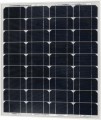Specs (STC)
Standard Test Conditions (STC) are standard test conditions that reflect the operation of a solar panel under ideal conditions. As part of the tests, the weather of a clear sunny day with an air temperature of +25 °C, no wind, solar intensity of 1000 W/m² and an emission spectrum relative to air mass of 1.5 is simulated. The surface of the solar cell must be placed strictly perpendicular to the rays from the celestial body. Note that in real operation of the solar panel, such conditions are extremely rare. However, in general, the characteristics of the STC allow us to evaluate the "passport" parameters of the energy storage device.
Power (Pmax)
The amount of electricity in watts that a solar panel produces in one hour in tests using the STC method. The panel must provide the declared number of watts during normal operation.
Nominal voltage (Vmp)
The voltage reading on the voltmeter during a solar panel test at the nominal power level according to the STC method. This parameter, Vmp, stands for Voltage at Maximum Power and is measured in volts. It helps determine which type of batteries the panel is designed for — either
12 V or
24V.
Nominal power (Imp)
Ammeter reading during solar panel testing under STC conditions. The value of the rated current Imp (Current at Maximum Power) is measured in amperes.
Open-circuit voltage (Voc)
The voltage generated by the solar battery in idle mode, that is, without connecting the load. Behind the abbreviation Voc stands for Voltage Open Circuit.
Short circuit current (Isc)
The current value under the condition of zero voltage (Short Circuit Current).
Waterproof
The level of protection is indicated by two digits according to the IP standard. The first digit indicates the protection against dust (maximum 6), the second indicates the degree of protection against water (maximum 8). The maximum degree of protection according to this standard is IP68, that is, complete tightness. There are also markings of the IPX4 type, where the first digit is not spelled out - this means that the solar panel has not been officially certified for dust resistance.
Number of cells
The number of photocells in the panel structure. Traditional solar panels are made with 60 or 72 cells on the entire plane of the panel. The Half-Cell module is designed to double their number (up to 120 or 144 cells per panel). This technology opens up more possibilities for capturing the energy of sunlight and increasing the efficiency of electricity generation. It is used in advanced models of solar panels.
Dimensions
Dimensions of the solar panel in unfolded form.

